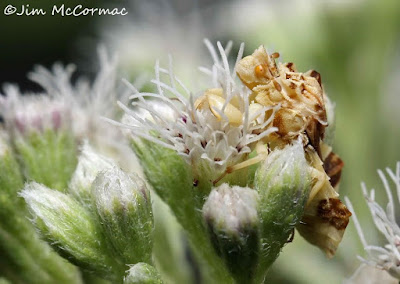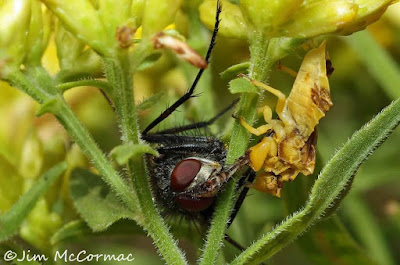Tis the season for meadows full of beautiful native wildflowers, such as this tall ironweed, Vernonia gigantea. Various goldenrods, asters, and other flowers of fall are starting to come on strong, too.
While a flower-filled field may look peaceful, in reality scores of wee killers lurk among the blooms. A flower can be a very dangerous place for a nectar-seeking pollinating insect. I did a pretty intensive field trip through several southeastern Ohio counties last weekend, and managed to find a number of specimens of one of my favorite killers in the flowers, the Jagged Ambush Bugs in the genus Phymata.
An ambush bug sits, rather uncharacteristically conspicuously, on the magenta flowers of ironweed. It is like a little gargoyle. Note the powerful raptorial forelegs. If a small bee, wasp, fly, or anything that can be overpowered lands here, it is likely doomed. With a quick lunge, the ambush bug will seize the victim, and then punch it with a syringe-like proboscis. Toxins in its saliva quickly immobilize the victim, and digestive enzymes rapidly decompose its innards. When a nice, slushy consistency has been reached, the ambush bug slurps out the contents.
The keen observer of Jagged Ambush Bugs soon notes that they come in an array of colors. I have read that at least some species can change color, chameleonlike, to match the flowers that they hunt in. I do not know for sure if that is true, but it makes for a good story. The animal in the photo above is nestled in the flowers of boneset, Eupatorium perfoliatum. Boneset, ironweed, and goldenrod are surefire bets for finding these interesting predators. Ambush bugs are very small and easily overlooked. Once one has developed an eye for them, they're easy to see and you might be surprised at how common they are.
I found this little chap to be in an especially showy setting - the flowers of a wonderful little mint known as dittany, Cunila origanoides. I dropped to the ground and spent 10-15 minutes with my camera trained on the ambush bug, hoping some luckless pollinator would fly in and get whacked. It was not to be while I was there, but given the number of tiny bees and flies in the area, I'm sure plenty of meals are scored.
The genus Phymata is not especially large in North America north of Mexico - 20 species or so - and diversity thins out even more east of the Mississippi. Apparently nearly all of the ones in Ohio and vicinity fall into three species: Phymata americana, P. fasciata, and P. pennsylvanica. Separating these species can be quite difficult, especially from photos, so I'm just leaving it at that.
This ambush bug hit the jackpot! It has killed a comparatively massive tachinid (tak-in-id) fly, illustrating the potency of the debilitating neurotoxin that it injects into victims. Not only did the elfin bug quickly KO the larger fly, it then drug it from the flowers and down into the plant, where it was better hidden.
The kill shown here is a great irony; karmic payback? Tachinid flies are parasitoids, laying eggs on hosts such as caterpillars and katydids. The fly egg hatches a tiny grub which quickly bores into the host and commences eating it alive. The fly maggot feeds and grows within its victim, ultimately killing it. This tachinid has met its match in this ferocious little ambush bug.
Keep an eye on the flowers this fall, and I'll guarantee you'll spot a Jagged Ambush Bug sooner or later.





No comments:
Post a Comment